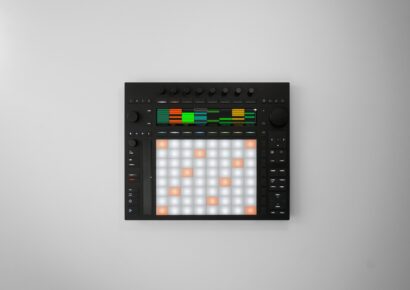Baby Audio BA-1 | Baby Audio | RRP: $49.00 USD
The Yamaha CS01 is something of an under-the-radar cult classic, with its entry-level price and toy-like appearance belying a fat analogue sound which has featured in all sorts of genres across the decades since its 1982 release, from 80s pop to 90s dancehall and 2000s indie electronica. A simple beast, the CS01 was aimed at the novice musician, as such featuring half-sized keys, a single oscillator, paired back controls, battery power, and even a keytar strap (how good was the 80s?!).
It’s perhaps fitting, then, that the first software recreation of this synth “toy” is by Baby Audio. In keeping with their motto “it’s an evolution, not an emulation”, they’ve meticulously modelled the original hardware and then upgraded the feature set with stacks of useful additions that drastically increase the versatility of this instrument and bring it up to spec with the demands of modern production without compromising its simplicity or fun factor.
Read more gear reviews here.
The BA-1 doubles the oscillator count of the original hardware (to two oscillators), each capable of triangle, sawtooth, and square waveforms, with the first also having a pulse width modulation setting and the second a white noise setting, useful for creating percussive sounds. A cross fader allows simple blending of the two oscillators, and an FM fader enables frequency modulation between them, a new feature not present in the CS01 but which is still very much in keeping with its 80s roots.
The original release of the CS01 featured a 12dB lowpass filter and lacked the ability to adjust resonance. The filter section of the BA-1 models that of the MK2 version, released in 1984, with a 24db lowpass filter and the ability to adjust resonance. Like the hardware, when pushed to the upper limits of the slider, the filter will begin to self-oscillate, creating some wild sounds.
A fairly typical envelope generator follows, with controls for attack, decay, sustain and release, plus a new feature allowing the synchronisation of these settings to your DAW’s tempo.
The LFO section is similarly simplistic, with controls for LFO speed and depth plus a toggle switch designating the target as either the pitch of Oscillator 1 or the filter cutoff frequency. A sneaky hidden function is accessible by clicking the word ‘target’ on the UI, which enables you to target the X-fade slider and modulate the blend of the two oscillators.
Next up is the side-chain; by default, increasing the ‘amount’ slider introduces a 4/4 ducking pattern synced to the host tempo. By clicking on the word ‘routing’, you can switch to an external side-chain, allowing you to duck the signal according to an external input – a common application is to sidechain the kick when using the synth as a bass, ducking the bass whenever the kick plays to avoid masking.
The effects section is simple but effective, inspired by the low-cost rack and pedal effects ubiquitous in the 80s. The tone control is comprised of two shelving filters, and the analogue-modelled drive control has two switchable modes, one based on an overdrive pedal which adds musicality and thickness, and one decidedly more lo-fi effect inspired by circuit bending the original hardware (for the uninitiated, check out this video on circuit bending). We’re also treated with some cheap and cheerful time-based effects: a delay with tempo sync, a shimmering digital reverb, and a chorus styled after Roland’s famous Juno synths.
One thing that Baby Audio have absolutely succeeded in with this soft synth is making it incredibly fun and simple to use. The effects section sounds fantastic; it’s difficult to make either drive circuit sound bad, and the time-based effects take any patch from mundane to Stranger Things soundtrack in a matter of seconds.
There’s 500 presets loaded by default, and though I’ve by no means tested all of them, each one that I played around with was well-crafted and clearly imaginable in a track. Pretty much everything is covered, from 80s synth strings to 303-style acid house leads, spacey pads, and lo-fi organ sounds. If this is not inspiration enough, simply hit the Re-Gen button and a the BA-1 will spit out a randomised patch – great for when you’re really stuck for ideas.
There are two rather unique features which you’re unlikely to find on many other soft synths. The first is an emulation of the CS01’s speaker, instantly imbuing your patch with lo-fi goodness. The second is the Battery fader, which models the effect of the audio degradation caused by operating the CS01 with dying batteries, introducing some pitch variation, distortion, fizz and filtering to the sound with excellent results reminiscent of a half-dead tape machine.
The BA-1 is not a workstation synth. You’re not going to be able to recreate every analogue sound on your favourite Kraftwerk record or produce an entire dubstep track from the ground up. However, it’s also not a one-trick pony or a novelty plugin, despite the fun features and the multiple options for the colour of the UI. Baby Audio have struck a delicate balance between being tweakable and programmable enough that you won’t get bored with the sounds it’s capable of whilst keeping the interface sufficiently simple that it’s instantly accessible without hours of tutorials on YouTube, and also having a distinct sonic footprint which renders it a unique option in your arsenal of synths.
If you’re producing any sort of retro or lo-fi synth based music, the BA-1 may just be your new best friend. For everyone else, downloading the free trial might just cause you to have enough fun that you wind up in the previous category.
For more information, head to Baby Audio.

